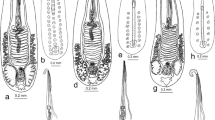Abstract
The life-cycles of two species of haploporid trematodes, Carassotrema bengalense Rekharani & Madhavi, 1985 and Saccocoelioides martini Madhavi, 1979, are illustrated. The molluscan host of the two species is the prosobranch gastropod Stenothyra blanfordiana (Nevill), which occurs in abundance in Chilka Lake, a large brackish-water lagoon. The cercariae are gymnocephalous, bi-ocellate and distomate. The cercaria of C. bengalense is characterised by the presence of thin lateral expansions of the tail, long tubular caeca, dense cystogenous glands and a Y-shaped excretory bladder. The cercaria of S. martini, on the other hand, has a simple tail, a prominent pharynx, short elliptical caeca lined by tall cells and an I-shaped excretory bladder. Both of the cercariae encyst on algae. Adults of C. bengalense occur in Mugil cephalus L. and Valamugil cunnesius (Val.), while those of S. martini occur in M. cephalus, Liza macrolepis (Smith), Etroplus suratensis (Bloch) and Hilsa ilisha (Hamilton).
Similar content being viewed by others
References
CableR.M. (1962) A cercaria of the trematode family Haploporidae. Journal of Parasitology, 48, 419–422.
CableR.M. & IsseroffH. (1969) A protandrous haploporid cercaria, probably the larva of Saccocoelioides sogandaresi Lumsden, 1963. Proceedings of the Helminthological Society of Washington, 39, 131–135.
CannonL.R.G. (1978) Marine cercariae from the gastropod Cerithium moniliferum Kiener at Heron Island, Great Barrier Reef. Proceedings of the Royal Society of Queensland, 89, 45–57.
DeblockS. (1980) Inventaire des trématodes larvaires parasites des mollusques Hydrobia (Prosobranches) de côtes de France. Parasitologia, 22, 1–105.
FaresA. & MaillardC. (1974) Recherches sur quelques Haploporidae (Trematoda) parasites des muges de Méditerranéen occidentale: systematiques et cycles évolutifs. Zeitschrift für Parasitenkunde, 45, 11–43.
GraefeG. (1970) Comportamiento poco comun de una cercaria pertenciente a la familia Haploporidae en la Argentina. Revista de Museo Argentino de Ciencias Naturales ‘Bernardino Rivadavia’, Ciencias Zoologicas, 10, 101–104.
GraefeG. (1971) Ungewohnliches Verhalten einer argentinischen Haploporidencercariae. Parasitologische Schriften-Reihe, 21, 179–182.
LumsdenR.D. (1963) Saccocoelioides sogandaresi sp. n., a new haploporid trematode from the sailfin molly, Mollienesia latipinna La Sueur in Texas. Journal of Parasitology, 49, 281–284.
MadhaviR. (1979) Digenetic trematodes from marine fishes of Waltair coast, Bay of Bengal, Families Haplosplanchnidae and Haploporidae. Rivista di Parassitologia, 40, 237–248.
Manter, H.W. (1957) Host specificity and other host relationships among digenetic trematodes of marine fishes, Premier Symposium sur la Spécificité des Parasites de Vertébrés. Institute of Zoology, University of Neuchâtel, pp. 189–198.
MartinW.E. (1973) Life history of Saccocoelioides pearsoni n. sp. and the description of Lecithobotrys sprenti n. sp. (Trematoda: Haploporidae). Transactions of the American Microscopical Society, 92, 80–95.
MartorelliS.R. (1988) Estudios parasitologicas en biotopos lenticos de la Republica Argentina. III. El ciclo biologico de Saccocoelioides carolae Lunaschi (Digenea) parasito de Cichlasoma facetum (Jenyns, 1842) (Pisces: Cichlidae). Neotropica, 32, 125–132.
Ostrowski de NuñezM. (1975) Fauna de agua dulce de la Republica Argentina IV. Una Cercaria de la familia Haploporidae (Trematoda), Neotropica, 21, 61–64.
RekharaniZ. & MadhaviR. (1985) Digenetic trematodes from mullets of Visakhapatnam (India). Journal of Natural History, 19, 929–951.
ShameemU. & MadhaviR. (1988) The morphology, lifehistory and systematic position of Haplorchoides mehrai Pande & Shukla, 1976 (Trematoda: Heterophyidae). Systematic Parasitology, 11, 73–83.
ShiremanJ.V. (1964) Carassotrema mugilicola, a new haploporid trematode from the striped mullet Mugil cephalus in Louisiana. Journal of Parasitology, 50, 555–556.
SzidatL. (1970) Saccocoelioides octavus n. sp. una nueva especie del genero Saccocoelioides Szidat, 1954 (Trematoda: Haploporinae Looss, 1902). Revista de Museo Argentina de Ciencias Naturales "Bernardino Rivadavia", Ciencias Zoologicas, 10, 87–100.
TangZ. & LinX. (1979) Studies on Carassotrema Park, 1938. Life histories and distribution. Xiamen Daxye Xyubao, 1, 81–98.
UenoN., IshiiK. & AbeH. (1930) On the cercariae parasitic in freshwater snails in Kumamoto prefecture. Kumamoto Igakkai Zasshi, 6, 965–976.
Author information
Authors and Affiliations
Rights and permissions
About this article
Cite this article
Shameen, U., Madhavi, R. Observations on the life-cycles of two haploporid trematodes, Carassotrema bengalense Rekharani & Madhavi, 1985 and Saccocoelioides martini Madhavi, 1979. Syst Parasitol 20, 97–107 (1991). https://doi.org/10.1007/BF00007386
Accepted:
Issue Date:
DOI: https://doi.org/10.1007/BF00007386




